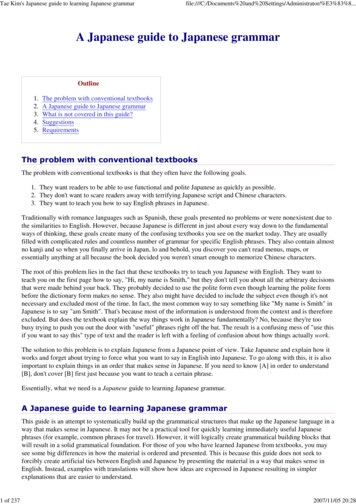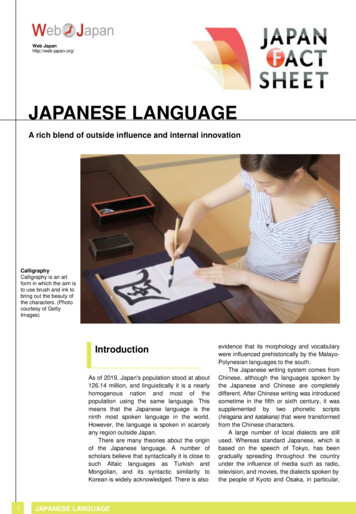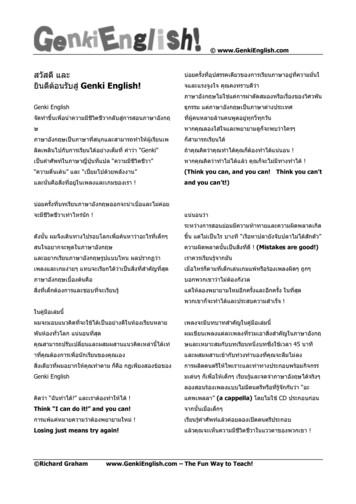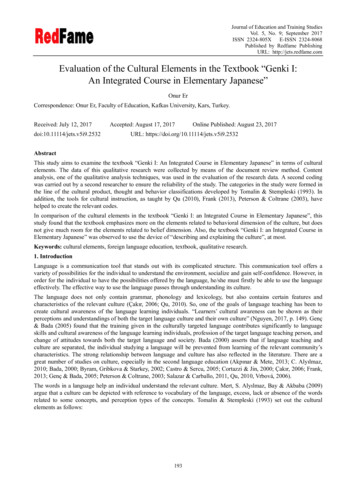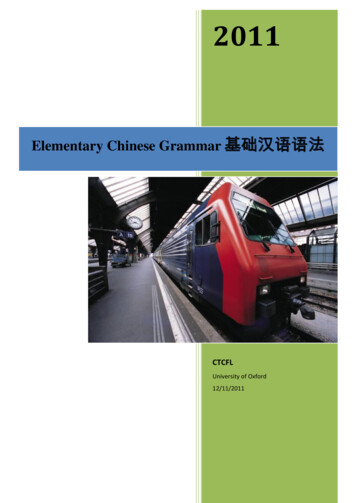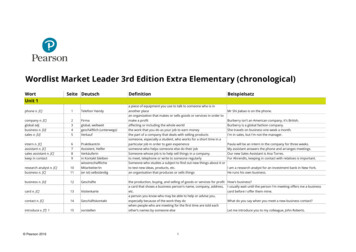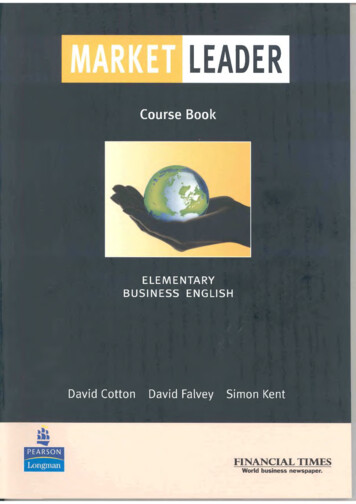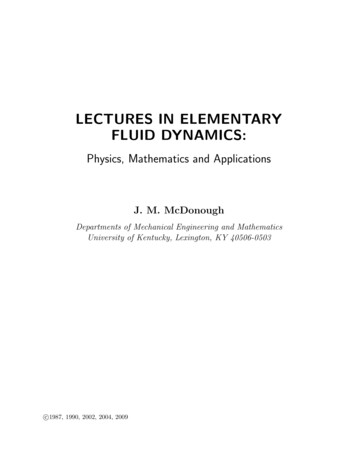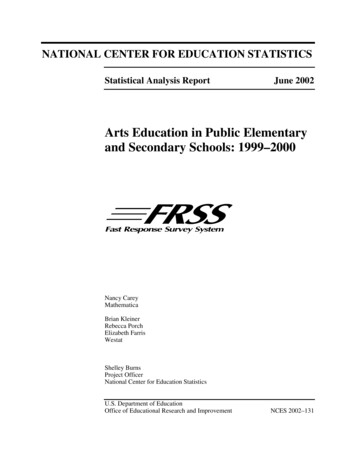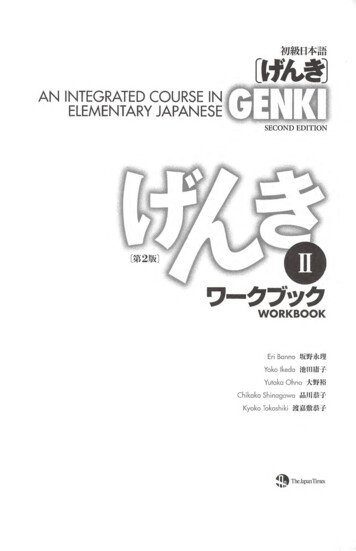
Transcription
ANINTEGRATED COURSE INELEMENTARY JAPANESESECOND EDITIONWORKBOOKEriBannoYoko IkedaYutaka1itfeffl/ffTOh noChikako Shinagawa nnJII3S-fKyoko TokashikiTheJapanTimes
WIt-Vx Koi'Tftg (D * 7 1C ti MP3 W (D9 y' 77 NftT i S fo'*«8TS UT 3t'oCD 7V- -?iiW T' A D?\ &* / 3l\ Note on the accompanying diskdisk that comes with this book containsTheThe files can be played on computers ordigitaldigitalaudiofiles inMP3format.audio players, but not onCDplayers.Copyright 2011 by Eri Banno, Yoko Ikeda, Yutaka Ohno, Chikako Shinagawa, and Kyoko Tokashiki.All rights reserved.Nopart of this publicationmay bereproduced, stored in a retrieval system,or transmitted in any form or by any means, electronic, mechanical, photocopying, recording, orotherwise, without the prior written permission of the publisher.February 2000First edition:Secondedition:October 2011Third printing: June 2012Illustrations:Noriko Udagawa4M Associates, Inc., and Umes Corp.Miho Nagahori, Yumiko Muro, Tomoki Kusumi, Tsuyoshi Yokoyama,and Kit Pancoast NagamuraRecordings: TBS Service, Inc.English translations and copyreading:Narrators:Typesetting: guildCoverartandeditorial design:Nakayama DesignOfficeGin-o Nakayama and Akihito KanekoPrinting:Tosho Printing Co.,Ltd.Published by The Japan Times, Ltd.5-4, Shibaura4-chome, Minato-ku, Tokyo 108-0023, JapanPhone: 03-3453-2013Website: http://bookclub.japantimes.co.jp/Genki-Online: http://genki.japantimes.co.jp/ISBN978-4-7890- 1444-1Printed in Japan
fiil&IStff’eto 4*HfA,§ J *3fetrt*fc*fc»Kf-4* b 3fcffrt#K4t *C7-*7yEl fcini* jE*ffv'iLfcon m*t lt,r§x. ij *#«K j!2niL l*o zommKit eo»o S 0*«o-Ciajc«PA*KM *«ot:i5»),aftl-CttiJto ffc, rSKMSJ &j**MP3 7 7 r/HwLt:* Ki&ttU i *)«V'*t Lf Lfcoit* 7 r f&- &iiJ Kit rtxDX.T,«t-9; -y07- y- Msafe0f to7-7 ' — h'Cl E 7)t:i Jl@tM« :&* ?§ to&*& s*3*BLfc&u\ rw *BJ-en w*t*B*fH - ** ? * toHNKMlWJ i:ttl!i:o L‘C3ot tt4ooMH *JR«t-C*») i toit (Using Kanji)T\(Kanji Practice)t« ftTV toFLi5:f%it\ H 7)At*V'TMlLSto ? iif X l'«I #fi:Lt f; otS*E11Sittt tf LtT'&itt-CV'i‘jZ'i*%&fc%M/uX frbffi&LXbt D7-77*'.y /f V' 07*#fflt it\iOWJ: fcJ»B*ffll
AboutThisThisworkbookCourseinisBookdesigned as a supplement for the textbook GENKI:additions and other changes to thenewtext.madeElementary Japanese. Revisionsworkbookin theAnIntegratedsecond edition have requiredto bringitinto conformity with theIn addition to the grammar, listening and kanji drills that were a part ofthe old workbook,weve addedaQuestions section to each chapter, which allowsstudents to create answers freely, using what they have learned in that chapter. Finally,the addition ofmadetheMP3format audio aids to the Listening Comprehension sections hasworkbook easierto use.The Conversation and Grammar sectiongrammarnewin thisbook containsaworksheet for eachpoint introduced in the textbook. In addition to providing practice onmaterial, the worksheets also help students to reinforce their understanding ofgrammatical topics and vocabulary encountered inAfter studying eachnew grammaticalearlier lessons.idea, students are given the opportunity toreview the material comprehensively through the Listening Comprehension andQuestions sections. The Listening Comprehension section for each lesson featuresthree or four tasks that involve listening to dialoguesThe Reading and Writing sectionand other recordedmaterial.consists of kanji worksheets (Kanji Practice)fill-in-the-blank questions about the kanji (Using Kanji).Newly introducedshould be written over and over on the sheet until memorized.First, traceprinted kanji samples, paying attention to the balance of the characters.by copying the kanji over and over againin theblank spaces to thekanjithe lightlyThenright.andpracticeFor strokeorder, please refer to the kanji chart in the textbook.For the fill-in-the-blank questions, students should read the entire sentence beforefilling inthe blanks in order to learn kanji in context.By usingthisworkbookintandem withJapanese with greater efficiency.the textbook, students will learn elementary
”5fc l\SK '\;O-0r}"j0fe U tg-SC S Ato'fitoi!ftA»l§:5im 13ii2—Potential Verbs —3 u-1-iiPotential Verbs-13144-155 ra*3-166&5 —177—i§ PeHL— H]H4 m8MKIffi9 Ccb 9-20?UU-212-223-234 fc5 '5Trr*)'--245Number fe/ Number U ft' Negative--25610 .15111 (ListeningflA 7CuoComprehension)-26-27L/ cL "Dcita5is23Form1-28--29Volitional-305—Using Sentences to Qualify Nouns—2-6KK eI7ilr . bd 'S41I6 m—Form —2 r —VolitionalUsing Sentences to Qualify 3136'cu/cfci -e/ofr-4-37-385 Bt-1-396 Bf—2407 t4/u7rurc-8HK j --44-45
—— ——3—T'KZtiWn?464475 a*fciv -r BUlC/ 'Cfc'S6M H HItlf\j L/W vity Pairs11512Transitivity Pairs2523 ru 553454557855orcTrr6H onorific Verbs26031Honorific Verbs23Honorific Verbs4 Z nZ&01 D625-Zk-h'-orcZ?63 Giving Respectful Advice616467(Listening Comprehension)65TlA/Uwo678C/tm20 ii1Extra-modest Expressions—692702Humble Expressions3Humble Expressions4Three Types of Respect Language715 &LV 726Questions Within Larger Sentences7Name8Item (Listening2 ‘'(bTLV lC LfComprehension)737475TlA/l/Wo93S21S681761Passive Sentences2Passive Sentences3Passive and4 ‘U3d-1)—177278 T & 5 D:79808153dU/ 6Adjective 82
78-83' of:2—Causative Sentences—3Causative cS l;f4Verb Stem &cTl’'-895H*-901678Causative Sentences' (Cl(MK miCfcs23ts-86- / fl 2 -87-—-8891-- o&/'91' cfcfjlC(ListeningComprehension)-C & z -92-93-941Verb Conjugation (Causative-passive)-952Causative-passive Sentences-973Passive and Causative-passive-984 rfe —-995-etc-1006 d (C 7r-78910-101-102—KK S1 -103(ListeningU 5s12I l6l 12Kanji Practice-109Using Kanji-110—Kanji Practice-111Using Kanji-112Kanji PracticeKanji PracticeUsing Kanji113-114Using Kanji—115-116
8 L m 17 mm 18sm 19mm 20ii1Kanji Practice1172Using Kanji1181Kanji Practice1192Using Kanji1201Kanji Practice1212Using Kanji12212m21m12m 22m12m23m12Kanji Practice123Using Kanji124Kanji Practice125Using Kanji126Kanji Practice127Using Kanji128Kanji Practice129Using Kanji130
Conversation and Grammar Section
eIS gals (D 13(T)FillinPotential2.fc J: "3. nt'4. ?)sbh5.t o6.ioT7.8.o 9. 10.-f*11. 13.te-formfaTfrll.12.Verbs—the chart.dictionary formEx.it potential'Spotential negative
l2 E-38ai(n) Writetwo things you can/cannot do and two things you were able/unable to doinchildhood.1Things you can do:.a.b.2.Things you cannot do:a.b.3.Things you were able to do in childhood:a.b.4.Things you were unable to do in childhood:a.b.
0 7,* 13 flH Potential Verbs—(T)Read theof thefirst halfsentences andinfillthe blanks with the potentialverbs. Determine whether you should use the affirmative or the negative.1.4JISl-fi /CT'.'/ctf)T\cfIt(speak)2.fr-r(swim)(thing)3.lzm ihZ nT\- /v«I5'j(decide)4.4'- iU\'X\'Z nT.tz&l&K4'oZl(go)tz *L5.(eat) 6.U l' 5/C& 7)T\4011(go out)(n) Translate the following sentences.1.What kind2.Where can I buy cheap3.Iwas not4.Iwas unable5.Iamof songs can you sing?clothes?able to sleep atall lastto eat a greenglad becauseInight.pepperwas ableto(k — v y) whenbecomea lawyer.Iwas achild, butIcan eatitnow.
03714” !S-35 Sim\Sm(I ) UComplete the sentences, using1.,(it is2cold)fe*tz (sleepy).(can play the guitar)(smart)3. i(Ihave atesttomorrow)(I-9have to meet the teacher)4.,OtH*/C '*b T-fotz(oftentellsa(doesn’t keep a promise)lie)5.(ri)jjm.(Iwas able to enter the university)(IhaveAnswer the questions and add reasons )\(CISA.lift*i* :QA-5 :Liiii' UT"t rI*l.many friends)tb itzV !/Mil/:U i' */0
SB(T) Describe the pictures with ir-5Z:T.Example:Z D *r— litt**7 »Ex. cakeTl" 0* i1.2.3.4.2.5.(n)Rephrase the sentences asthesameExample:.2.interestingthe example, usingpictures.-"fthi1in 1 T— 3rX f fac4.ring(3.4.expensive5.5.not smart15
i6»»aB-gaai757m 13isZd*Z (T) Reply to A, using1.A:X.I'U B2.A# 753.A?5'A, L i L /coo J:T t Tirt:Xi)' bB'':i:'Eiofc'L** .J:»:15 A,B4.A::C HS n#3Sli# ;J'A,:: BiUnUtT,KTtfc Lv'T-fJto5' U Y5(n) Write three placesoyou have never been to and things you want totry there,using "C2*7cU.Example:X iff]/(Mongolia)A/cV'T-f o1.2.3.fiCffoT /c Tton2 T, iJ(horse)hfoTo
& 5, answer the questions according to the given(T) UsingQExample:A:0 mfiotf(iU t Tlnb\B 08 0ftt,:tACJitiilc* J:91.QA2.Q:i*l J:(x u fc3.Q:' (ff74 X\.'fi:\'Ti'4'o(X'U7 41:mtn tzZ(xl O*)i-TjJ'otec:Q:?MI izffi&5.r fzZ *j -fl'A:HtSttkff -otzZrt'A/C : Stefto/cZ!S".'C A2.QA3.Q4.Q‘Jl'i-M'o:::o ::tf'fcAi':Uii UAO#):Example:Qi::(n) Answer the questions, using1.iO&)tni*iiz tecAll tA*'AO0B1B)(x BfBi T-r jK if B:;4'i-fiK'Ji-Tocues.:Ui* \ 'T*f 0
*0 57,UoUtt ocT/u t»'U%t)'/o(T) Translate the following sentences.(CD one hour a day.1.Mary listens2.John goes to a supermarket once a week.3.Michiko goes shopping twice a month.4.Ken goes abroad oncen) Writehowto a Japanesea year.often/long youdo the followingactivities.Ifyou are not '5UVExample:watch 0 C——TV ''Ityour mother—2.brush your teeth—3.sleep4.cut your hair5.do physical exercises1.call6.—catch a cold——ri'A,bv 'xU C JL i&ocertain,use
8BtK f X\hjH(Listening Comprehension)UttO(A) Listen to the job interviewsanswersapplicants. Writeinbetween a company personnel interviewer and jobJapanese orLA bSlI 'rTi U(B)(C)Kenx iflitlit'is' t uutitKyoko and Robert. Marktalking tois)Ken asked Kyoko and Robertb.()Kyokocan’t helpc.()Kyokoisd.()Ken’s younger sistere.()Robertisf.()Robertwill callg.()Robert knows somebody whonot goodOisisfirstb.-fe-y-iic. 74.ifthe statementis5A.true,t*0aand markbusy.busy tomorrow.Kenif hecan cancel the appointment.may beinterested in teaching.'fX(Switzerland)X 7 is yb % tlf 7)Ali-tr— 7 7 7 7(sports club)impressions on each item?(fitness1ttomachine) "-)HtZizh-To7)-i a.02.3.A *A& i t, coming tomorrow.*VtIfo'x.t in*HUict. i'at English.a.yA * A & tare shopping online. ( iwi3-care their-fifoE'to take his place at his part-time job.Ken because she* XWhatV'@wi3-bnot.Two peopleS IAt It i iA'4'AJ: (T a. (1.f»fBSATAones. L#Jwi3-aZlrfr Jjmncircle the appropriate0LTTt oIti'—LA LTTt oX t-k n Ally j y bHU O' hA-/)' 0L'oITWo
20 15 :%;&§037,1 / . 13 i .(T) rc'cTl'ioB lgZrU .TZfc(iA r(Answer the questionsinJapanese.)(Ztf'ol.UJ:)iUUn-* U3.) 0#, c ftts2/btf'o7intztz5.‘ItLi «i't4.Z fttsv 'T ttJ'o(Answer with L.)WlX&tzt'' tzT'lrt'o4 1CB T UTA/A'tt oic6.liA.4'lc—4'4tci ,icHA,i-fjJ'oreojfiin)B*ET?*ur fc**i/ o(2A ' " /(ZWrite about your current part-time job or a former part-time job.1.EX tttfc*T-f -h'/ T L / Xrtl2.—l'* BfPe'jlZ'.' btbV'iLtzti'oU 7)Xh3.&A/(Zfb Uv'itVlT iltzt\
15 %%» 21(»l4»lgu'(T) Write whether or not1.v '2.frAyou want thefollowing.(3.ttt5 '*3L(n) Write whether or not you1.A wanted the following when you were achild.v2. 5& o3.##i;(l)tiAnswer thefollowing questions.**14*111.C.2.3.i:4\&(c W— #11&(cL T-TjJ'ofA,b#Fb1 & Z%b4*llCrt'A,rt'faLv'T-T 'oLTTthLv'T-TtJ'oif9LTTth
0 722 f -3 ii14 0(T)Complete the sentences, usingl.Tclt L*/Cli(stingy)2./T AJi(not interested in Kabuki)3.ctbifi(didn’t play with stuffed animals)4.HX3X,li(eat four times a day)5.fcltlS/Ui(proposed marriage to Mary)(n)Read eachExample:situation&-%Z *—and make a guess.L, t '&V%Z 3*oYour guess: &3 '‘*/C JLT'.'i't' 0A, 11 i/3 AjbAl'tiLH -If/C 01.—2.J:—Your guess:'o &z -t x , 0Your guess:x-tA,Ui *il*3.'inT-fob a n4.—*Your guess:It*dm'-h*AJi Ttit'—Your guess:
03723,('*14rH if 5/ ns/feS5(T) The picturesPicturebelow indicate who gave what to whom. Describe them usingAExample:.1.(give)X—*(receive)If, , * Al-11 1 X/ 11 X—(give)(receive)B23. (give)(receive)(ri)Answer the A,UH2following questions.Ufa 1.IfL fz ii\ fd'tlizftM'iLfzti'ofcUijr-r o.Xz/Un*tcIf iLf: 0LI /CPicture 5l:fim 'oTc o
24 7 7.3 )2A iL14iiQ /c5 !:3' -rZ)'(T)Complete the dialogues, using 7c5 ' oTr fr'.2.1.a/ ',CT-fc:(CB(5A,Lrt'i'L*CTfc:(send a resume to the company)3.A'-frt:'A T'-fo4.B:(go to a party)5.A: *tT /CT-fcO?)'B:(go tobedearly)A:fXB:(consult with the teacher)ALA/CT-fc: 1'BO':(go to the police(n)Make aA:dialogue according to the cues.l(What’s wrong?)2.oconfessing the problem3.ogiving advice4.o(Iwilldoso.Thank you.)
14 0 Number fc/Number Ob' Negative1.(T) Translate the following sentences.you think the numberissmall,2.KimuseIfyou think the numberislarge,usefc.IfUfr'”ifUfr'.has seven cars.3.4.John read three bookslast year.5.Mary hasthree part-time jobs.6.7.Johnslept fivehours yesterday.Takeshi has sixcats.Michiko has two DVDs.Ken has onefriend.(n) Answer the following questions.necessary.,2.*A,4\V'i3U‘JO'*75'.A/tUse “number fc” or“number
26 ” I -S:; gIcf-IKUM#14i (Listening Comprehension)tl hu Utf and draw arrows to indicate how the(A) Listen to the dialogue carefullypassed around.ticketwas@wm-a(WF) Cl1)(TUT)(B)Takako helpsinternational students with theirListen to the dialoguesQuestions:and answer the questions.oToJ(a)(b)1.problemsx tzt'Z* Lli L xTLat0 wu-b*-rL i L/c 'oL-ToTt'i - l'tzt'Z2.X— — (Disney)j7(a)@ li(b)a Japanese school.Ll'*L nrxTt 'oKfoTuJ(a)@ liL/col'(b) tz3.L r T3K' ''fXL'hTt 'oKfoToi(a)@ liL/- 0i'(b)tzt'Z*L T)TK'M XT-f tf' 0(C) Michiko’s younger brother’s birthdaybetween Michiko and her younger1.Writea.b.((c.L T/LL*)coming soon.brother, Ichiro.O for the ones Ichiro wants, and)is(X0wi4-cfor the ones he doesn’t want.) e.( fffffd.(i Lti*)A%Z * X ( — gp S X, left fclf * ofctefc»J()ffl.o' t Itl'2.Listen to the conversationT-f 'o
f 0 57,I »! 27QI S«7?S .r /c U,iz1.ru/lztzjftiit (recently),/c U-'f T tM'iLtz 'ofclch 7) T\2.V'iL/c'tlT)"' &A,/:!)'ot3.75'-? fcA/UHtftzA,Intf7F4.5.— #ii'. 'TV-tf &t5'-A, 71/ '/ )ITTt oT-ftf'o*lcICWII&lc —LoT-fjJ'oF B*BT?*wr fSU— oTl'itITtth(Youmay use L7 Nor t.)otrWrite about yourlifeten yearslater,usingand
3—T'KZtiWn? 46 4 a*fciv -r 47 5 BUlC/ 'Cfc'S 48 6M HHI(ListeningComprehension) 49 tlf\jL/W o 7 50 ZTt mism 1TransitivityPairs— 1 51 2TransitivityPairs 2 52 3 ru 5 53 4 54 5 5 55 6 orcTrr 56 7H (ListeningComprehension) 57 8ItIUt 58 ztn Hl9iS 1HonorificVerbs— 1 59 2HonorificVerbs 2 60 3HonorificVerbs3 GivingRespectfulAdvice 61 4 Z nZ&01 D 62 5-Zk-h'-orcZ? 63 6 64 7 .
